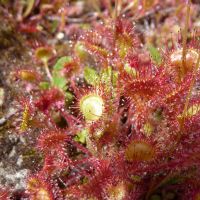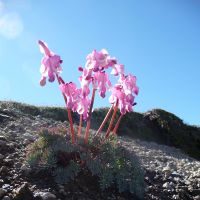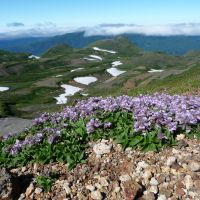Japan, though it has a very different image, is on the same latitude as southern Europe and North Africa, while my nearest city, Sapporo, is oddly enough on the same east-west parallel as France's boisterously cosmopolitan second city of Marseille on the Mediterranean.
Tokyo, meanwhile, shares its latitude not only with exotic Tangier in Morocco, but also Tehran and a point midway between San Francisco and Los Angeles in California. And, perhaps surprisingly, Okinawa's capital of Naha — which lies at roughly the same latitude as Hawaii — is further from the North Pole even than India's capital, Delhi.
Given such information, it may come as no surprise that Japan's climate drives ecosystems resembling both those in the subtropics and ones in the warm-temperate zone. Considering the parallels with North Africa, though, you might expect more deserts here — but that's where topography and global climatic systems come into play.
That Japan shares similarities with the high latitudes of Russia, particularly those of northern Kamchatka and Chukotka, may come as more of a surprise, as those regions lie some 3,000 to 4,000 km to the north of even Japan's northernmost island, Hokkaido.
A straight-line journey to the north-northeast, from Tokyo to Russia's eastern outpost at Provideniya, a distance of nearly 5,000 km, requires a flight ticket and a passport, but in ecological terms it can be replicated by donning boots and a backpack and hiking for just a few kilometers up beyond the tree line.
Depending on where you start, such as perhaps at Norikura in the Japan Alps, straddling the border of Gifu and Nagano prefectures, this may require little more than a short walk from the car park. Elsewhere, a hike of several hours may be necessary to achieve the same goal.
For me, in west Hokkaido, my easiest access point is on the flanks of 1,041-meter Mount Tarumae in the Shikotsu-Toya National Park, which lies to the southwest of Sapporo. There, the tree line can be seen very well a mere 20 minutes from the car park, although in Hokkaido the best access to it and to the alpine zone above it is to be found in the Daisetsu Mountains in the center of the island.
Worldwide, of course, the tree line is not at a fixed altitude, and it is more of an ecological definition that depends on the local climate, the prevailing wind and the accumulation of snow. Hence in central Honshu it may be above 2,800 meters, though in parts of Hokkaido it is below 1,000 meters — while in Russian Chukotka even at sea level there are no trees, and they don't start appearing on the landscape until far to the south.
In the Arctic, the tree line snakes around the globe through Russia, Alaska, Canada and Scandinavia, bound by an isotherm (a line through places of equal temperature) connecting places where the mercury in July does not rise above an average of approximately 10°C. To proceed beyond that isotherm is to enter a realm where low temperatures, permafrost and exceedingly prolonged winters preclude trees from putting down deep roots and raising sturdy trunks. It is not that tree species cannot grow there at all; it's that beyond the tree line the few species hardy enough to survive — such as dwarf willows, dwarf birches and dwarf alders — all grow in prostrate, mat forms reluctant to raise even a twig beyond the relatively milder microclimate within a few centimetres of the ground's surface, lest they are exposed above the winter snow layer and frozen off or blasted off by the wind.
This Arctic habitat know as tundra comes in various forms. In wet areas rich in nutrients and minerals, it may support lush mini-meadows of colorful annual wildflowers. These use the brief summer to rush to dizzying heights of 20 or even 30 cm, briefly towering over nearby mat-form dwarfed willows. Come autumn, which is late August at these latitudes, and the flowers begin to die back as cold winds cut them off and they are left to overwinter as wind-scattered seeds.
Other, drier areas of tundra, with much of the surface rock and thin soil exposed, are known as rocky tundra (resembling even stony deserts such as ones in the U.S. Southwest or North African countries such as Morocco).
On the surface of the rocky tundra, shattered and scattered rocks indicate the pattern and extent of repeated freezing and thawing that can sort small rocks and gravel by size and can heave and buckle the surface so that it's difficult for plants to take permanent hold. In such habitats, it is not only the dwarfed tree species that grow in prostrate mats, but also all other plants. Like lichen colonies on a rock, the plants spread out across the bare ground forming roughly circular patches, exposing themselves as much as they can to the sun and as little as possible to the wind — except when it serves their purposes for pollination or seed dispersal.
In an uncanny way, the tundra of the far North is replicated even here in Japan — in the zones above the tree line know as the subalpine and alpine zones. These zones experience many of the same life-limiting and life-influencing factors as found on the tundra, namely low average temperatures, intense summer sunlight, strong winds and long winter periods of freezing.
Given the similarities in conditions that they experience, it should not come as a surprise to learn that the plants of these two widespread regions, the tundra and the alpine zone, have come up with similar adaptations enabling them to survive and thrive under these conditions. Even some of the same species occur in the two widely separated habitats.
I learned my first "alpine/tundra" plant species many years ago when studying in Iceland, and I found that knowledge surprisingly applicable in later years in northern Norway, in Arctic Russia, in northern Alaska and in the mountains of many parts of the world, including Japan.
The prostrate mat-formation mentioned already as a means many plants adopt to avoid the wind's worst blasts is much in evidence on Mount Tarumae.
Other adaptations to cold and windy conditions include very slow growth to minimize the exposure of delicate new shoots to harsh conditions, and hairy leaves, which help to trap warm areas of air around the plant and raise the temperature of the plant mat several degrees above the surroundings.
This relatively warmer local environment makes such plants attractive to insects, including flies, which may serve as important plant pollinators. Flowers in the alpine zone need their pollinators just as much as flowers elsewhere — it's just that they have fewer insect species to enlist.
Many of the more showy subalpine and alpine plants have trumpetlike flowers, which are attractive to bumblebees. These large insects are themselves hairy and better adapted to cold conditions than most, and they play a very important role in both tundra and alpine ecosystems.
One facet of chilled, frozen or waterlogged soils — on the tundra, in the alpine zone or in wet swampy areas — is that they may provide insufficient nutrients for many plants. To help circumvent this, a lifestyle not commonly associated with plants has evolved.
In contrast to the vast majority of their kind that use green chlorophyll to photosynthesize, so generating their energy requirements from sunlight, water and air (oh to take a leaf from their book and solve our energy needs in such a non-polluting and eco-friendly way), a select few plants have, as an addition, evolved carnivorously. These plants that eat things, most particularly insects, are known as insectivorous plants.
Visitors to subtropical and tropical areas will likely know the extraordinary pitcher plants, which catch their insect prey in small, slippery-lipped jusg filled with digestive fluid. However, in the Arctic, on the tundra, in the alpine zone and on poor boggy soils, another group of plants has achieved successful insectivory: These are the sundews in the genus Drosera.
Sundews are easily overlooked. Small, ground-hugging and pallid, with the tiniest of white flowers atop a tall slender stem, there is not much to distinguish them. Sometimes they grow in sufficient densities for their slightly reddish tinge to draw attention to them. Then, on closer inspection, the ground may turn out to be dotted with them all glistening in a strange way. The glistening comes from droplets of sticky secretion around the fringes of their leaves, which, when triggered by a hapless insect that wanders on to a leaf, fold inward to allow the plant to digest the bug.
It's a strange way to make a living, but it seems to work well under harsh conditions, as the same species occurring here in Japan can be found around the Northern Hemisphere from Iceland to Kamchatka, and from Alaska to southern Greenland.
Mark Brazil, naturalist and author, has written Wild Watch for 30 years and, as the founder of Japan Nature Guides, he also leads wildlife, birding and photo safaris nationwide. His latest book, "Field Guide to the Birds of East Asia," and his earlier "A Birdwatcher's Guide to Japan" and "The Birds of Japan," are available in bookstores or via www.japannatureguides.com




















With your current subscription plan you can comment on stories. However, before writing your first comment, please create a display name in the Profile section of your subscriber account page.